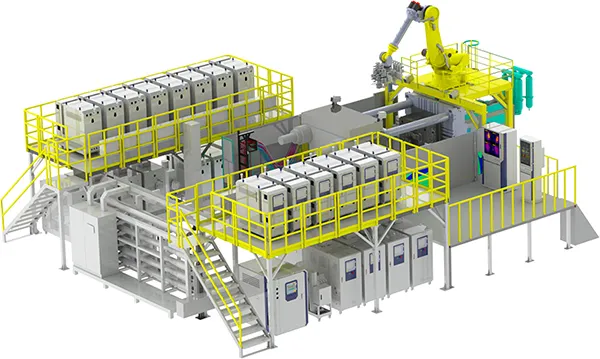
This changes the traditional approach of multiple independent temperature control units by highly integrating various devices such as oil temperature machines, water temperature machines, mold cooling stations, and pure water systems into a single system. For example, in large-scale integrated die casting, the past approach required 30–40 water temperature machines and 10–15 oil temperature machines, taking up a large floor area and creating management complexity. Our integrated design solution significantly reduces the number of temperature control units. For instance, Xinyu’s CTM large-scale high-temperature water control station can replace more than ten traditional water temperature machines with a single unit, making the layout of large die casting island temperature control groups more compact and effectively saving floor space.
Temperature control zones are divided into low-temperature (5–35℃), medium-temperature (60–120℃), and high-temperature (150–180℃ or higher). This allows targeted temperature control for different mold areas or different production stages. With centralized control, all zones can be uniformly managed and adjusted to ensure mold temperature uniformity and stability.
Some equipment, such as control boxes, adopt a split-structure design and are placed directly beside the mold. This shortens medium transport distance, reduces heat loss, and enables intermittent water/oil supply with fast response speed, allowing quick adjustments according to real-time mold temperature changes.
Equipped with an advanced monitoring system, it collects and analyzes temperature, flow, pressure, and other data from each circuit in real time. Data analysis helps predict equipment failures and mold anomalies in advance, enabling timely maintenance and adjustments. This ensures continuous and stable production while optimizing temperature control strategies to further improve efficiency and product quality.
The system can be connected with die casting machines for synchronized control. According to machine operating status and process parameters, it automatically adjusts its own parameters, realizing intelligent coordination in the production process and improving both efficiency and automation levels across the die casting island.
Our one-stop die casting island mold temperature control solution, with its outstanding integrated design, precise temperature control capability, energy-saving performance, cost reduction advantages, and advanced technical features, provides strong support for efficient and high-quality die casting production. It is the ideal choice for die casting enterprises seeking to enhance competitiveness.
In the die casting of automotive engine blocks and cylinder heads, precise temperature control systems are critical. For example, a well-known automotive parts supplier adopted an advanced die casting mold temperature control system. By arranging dense cooling channels and precise heating elements inside the mold, combined with intelligent control, it achieved accurate temperature regulation. This ensured that the produced cylinder blocks and heads met the highest standards of strength, dimensional accuracy, and surface quality, significantly reducing scrap rate and improving production efficiency.
For aluminum housings of smartphones and tablets, extremely high demands are placed on surface quality and dimensional accuracy. An electronics manufacturer applied a high-performance die casting mold temperature control system. This system could rapidly adjust mold temperatures within very short timeframes, ensuring uniform metal flow during casting and preventing surface defects or internal flaws. The result was housings with excellent appearance and strong mechanical properties.
In aerospace, key parts such as aircraft engine blades require extremely strict mold temperature control. An aerospace manufacturer used specialized die casting mold temperature control technology capable of independent and highly precise regulation of different mold sections. This ensured uniform microstructure and superior mechanical properties of the blades, meeting the industry’s high standards for quality and reliability.
In the production of large integrated die castings such as automotive body frames for new energy vehicles, an advanced mold temperature control system enabled uniform and precise control of large molds. This resulted in structural parts with outstanding strength, dimensional stability, and weldability supporting both lightweight design and higher production efficiency for new energy vehicles.